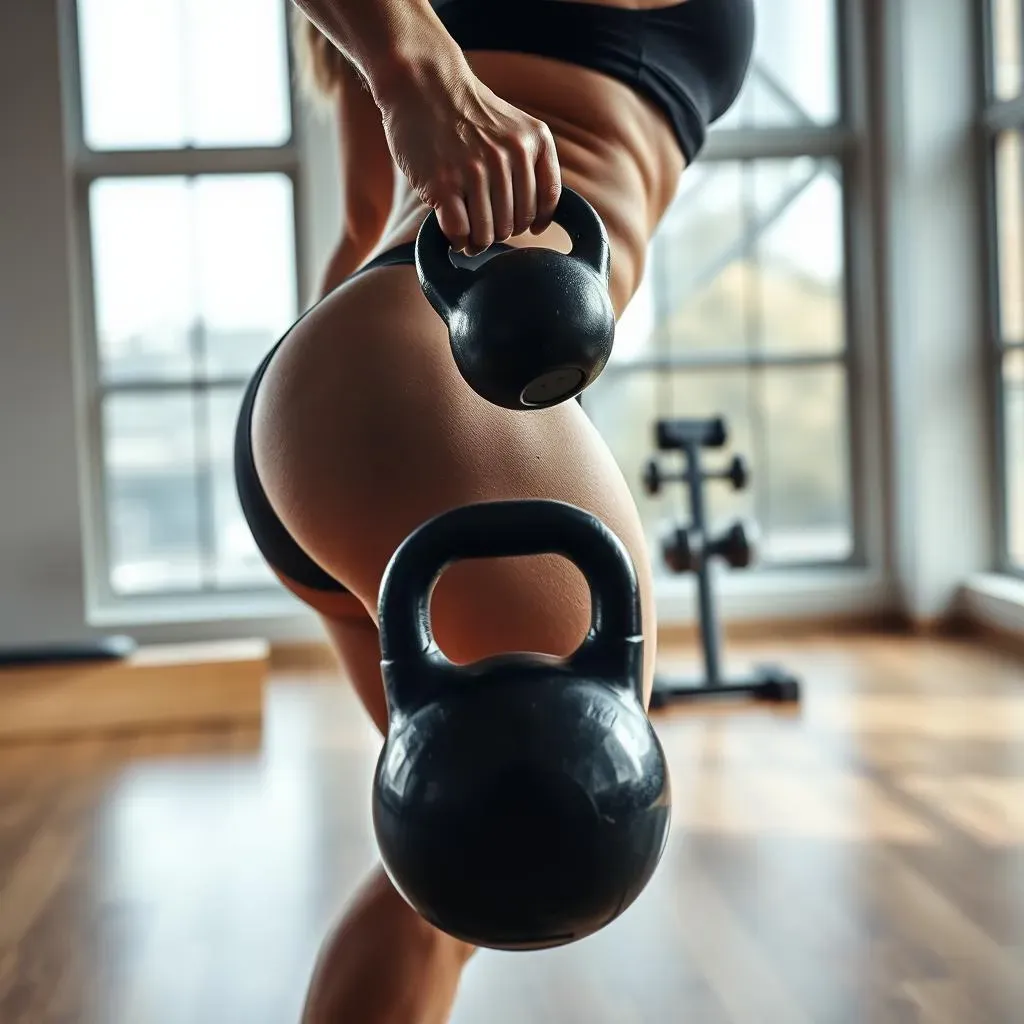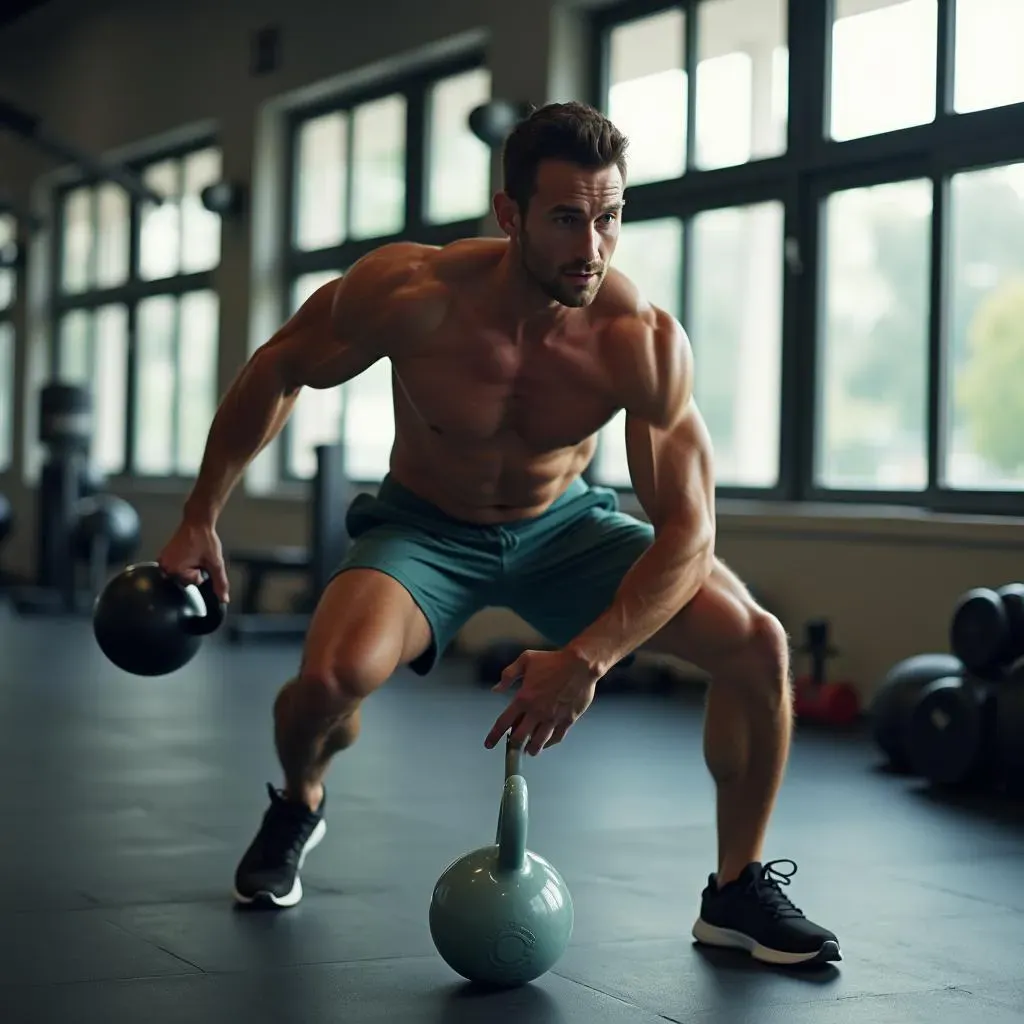Table of Contents
Ready to torch calories, build serious strength, and feel amazing? Then it's time to discover the power of the workout kettlebell full body transformation. Forget endless hours on the treadmill or isolating muscles with machines. Kettlebells offer a dynamic, full-body approach to fitness that's both effective and engaging. This isn't just about lifting weight; it's about learning to move your body as a single, powerful unit.
Unlocking Full Body Strength: Why Kettlebell Workouts Reign Supreme

Unlocking Full Body Strength: Why Kettlebell Workouts Reign Supreme
Efficiency and Effectiveness: The Kettlebell Advantage
Let's face it, time is precious. We're all juggling work, family, and trying to squeeze in some semblance of a social life. That's where kettlebells shine. Unlike traditional weightlifting that often isolates specific muscle groups, kettlebell exercises engage your entire body in a coordinated, functional movement. Think swings, snatches, and cleans – these aren't just about biceps; they're about power, coordination, and core stability. You're working multiple muscle groups simultaneously, which translates to a more efficient and effective workout in a shorter amount of time. It’s compound movements that give the best bang for your buck.
Want to get your heart rate up while building strength? Kettlebells deliver on that front too! The dynamic nature of kettlebell exercises elevates your heart rate, providing a cardiovascular workout alongside strength training. This dual benefit makes them a fantastic option for anyone looking to improve their overall fitness without spending hours doing separate cardio and strength sessions. I remember when I first started using kettlebells, I was shocked at how winded I got after just a few sets of swings. It was a wake-up call to how much I was neglecting my cardio!
Beyond Strength: Power, Endurance, and Functional Fitness
Kettlebells aren't just about building muscle; they're about developing functional strength and power. The unique offset center of gravity of a kettlebell forces your body to constantly stabilize and control the weight, engaging your core and improving your balance. This translates to real-world benefits, making everyday activities like carrying groceries, lifting boxes, or even just walking feel easier and more stable. You're not just getting stronger in the gym; you're getting stronger for life.
And let's not forget about endurance! The repetitive nature of many kettlebell exercises, like swings and snatches, builds muscular endurance, allowing you to perform activities for longer periods without fatigue. This is crucial for athletes, but also beneficial for anyone who wants to improve their overall stamina and resilience. It's not just about lifting heavy; it's about lifting repeatedly and consistently.
Here's a quick look at the benefits we're talking about:
- Full-body engagement: Works multiple muscle groups simultaneously.
- Cardiovascular benefits: Elevates heart rate for a cardio workout.
- Functional strength: Improves real-world movement and stability.
- Power development: Enhances explosive strength and athleticism.
- Endurance building: Increases muscular endurance and stamina.
Versatility and Accessibility: Kettlebells for Everyone
One of the best things about kettlebells is their versatility. With just one kettlebell, you can perform a wide variety of exercises targeting every muscle group in your body. This makes them a cost-effective and space-saving option for home workouts. No need for a fancy gym membership or a room full of equipment; a single kettlebell can provide a complete and challenging workout.
Furthermore, kettlebell training is accessible to people of all fitness levels. Whether you're a seasoned athlete or just starting your fitness journey, you can find kettlebell exercises that suit your abilities. Start with lighter weights and focus on mastering the proper form before progressing to heavier loads. With a little guidance and practice, anyone can reap the benefits of kettlebell training. I started with an 8kg kettlebell, and now I'm swinging a 24kg! It's all about progression.
Kettlebell Exercises for a Full Body Assault: Form and Function

Kettlebell Exercises for a Full Body Assault: Form and Function
Mastering the Kettlebell Swing: The Foundation of Full Body Power
The kettlebell swing is arguably the most iconic kettlebell exercise, and for good reason. It's a powerhouse movement that engages your hamstrings, glutes, core, and back, building explosive power and improving your cardiovascular fitness. But it's also an exercise where proper form is absolutely crucial to avoid injury and maximize its benefits. Think of it as a hip hinge, not a squat. The power comes from driving your hips forward, not from lifting the kettlebell with your arms. Your arms are just along for the ride!
To perform a perfect kettlebell swing, start with the kettlebell a few inches in front of you. Hinge at your hips, keeping your back straight, and grab the kettlebell with both hands. Hike the kettlebell back between your legs, like you're hiking a football. Then, explosively drive your hips forward, swinging the kettlebell up to chest height. Let the kettlebell swing back down between your legs, controlling the movement with your hamstrings and glutes. Repeat for the desired number of repetitions. Remember, it's all about the hips! Squeeze those glutes at the top of the swing!
Here's a quick checklist for nailing your kettlebell swing:
- Hip hinge: Focus on hinging at the hips, not squatting.
- Straight back: Keep your back straight throughout the movement.
- Glute activation: Squeeze your glutes at the top of the swing.
- Controlled descent: Control the kettlebell as it swings back down.
- Breathing: Exhale as you swing the kettlebell up, inhale as it swings down.
Beyond the Swing: Essential Kettlebell Movements for a Total Body Workout
While the swing is a fantastic exercise, it's just the tip of the iceberg when it comes to kettlebell training. To truly unlock the potential of a full body kettlebell workout, you need to incorporate a variety of movements that target different muscle groups and movement patterns. Think of exercises like goblet squats, which build lower body strength and improve your squatting form; Romanian deadlifts, which target your hamstrings and glutes; and overhead presses, which build shoulder strength and stability. Each exercise brings something unique to the table, contributing to a well-rounded and effective workout.
Don't be afraid to experiment with different kettlebell exercises and find what works best for you. There are countless variations and combinations to explore, keeping your workouts fresh and challenging. And remember, proper form is always paramount. If you're unsure about the correct technique, seek guidance from a qualified kettlebell instructor. A little bit of instruction can go a long way in preventing injuries and maximizing your results. I've seen so many people butcher a Turkish Get-Up; it's worth getting some professional advice!
Here are some essential kettlebell exercises to incorporate into your routine:
Exercise | Target Muscles | Benefits |
|---|---|---|
Goblet Squat | Quads, glutes, core | Builds lower body strength, improves squatting form |
Romanian Deadlift | Hamstrings, glutes | Strengthens posterior chain, improves hip hinge |
Overhead Press | Shoulders, core, triceps | Builds shoulder strength and stability |
Kettlebell Clean | Full body | Develops explosive power, improves coordination |
Turkish Get-Up | Full body | Builds stability, mobility, and core strength |
Crafting Your Kettlebell Full Body Workout: A StepbyStep Plan

Crafting Your Kettlebell Full Body Workout: A StepbyStep Plan
Assessing Your Fitness Level: Know Before You Go
Before you jump headfirst into a workout kettlebell full body routine, it's crucial to assess your current fitness level. Are you a complete beginner, or do you have some experience with strength training? This will determine the appropriate weight, intensity, and complexity of your workout. Starting too heavy or too intense can lead to injury and discouragement. Be honest with yourself and start where you are. It's a marathon, not a sprint!
A simple way to assess your fitness level is to perform a few basic movements, like squats, push-ups, and planks, to see how many repetitions you can do with good form. This will give you a baseline to work from. If you're unsure, consult with a fitness professional who can provide a more comprehensive assessment and personalized recommendations. They can help you identify any weaknesses or imbalances and create a workout plan that's tailored to your specific needs. Remember, it's always better to err on the side of caution and start slowly.
Consider these questions when assessing your fitness level:
- What is your current level of strength and endurance?
- Do you have any existing injuries or limitations?
- What are your fitness goals?
- How much time can you dedicate to working out each week?
Choosing the Right Kettlebell Weight: Finding Your Goldilocks Zone
Selecting the appropriate kettlebell weight is essential for both safety and effectiveness. Too light, and you won't challenge your muscles enough to see results. Too heavy, and you risk compromising your form and potentially getting injured. The key is to find that "Goldilocks zone" – the weight that allows you to perform the exercises with good form while still feeling challenged. It's a delicate balance, but it's worth taking the time to get it right.
As a general guideline, women often start with an 8kg (18lb) or 12kg (26lb) kettlebell, while men typically start with a 12kg (26lb) or 16kg (35lb) kettlebell. However, these are just starting points. It's important to consider your individual strength and experience. If you're unsure, it's always better to start with a lighter weight and gradually increase it as you get stronger. You can also use different weights for different exercises. For example, you might use a heavier kettlebell for swings and a lighter kettlebell for overhead presses. Remember, progression is key!
Here's a table to help you choose the right kettlebell weight:
Fitness Level | Recommended Weight (Women) | Recommended Weight (Men) |
|---|---|---|
Beginner | 8kg (18lb) - 12kg (26lb) | 12kg (26lb) - 16kg (35lb) |
Intermediate | 12kg (26lb) - 16kg (35lb) | 16kg (35lb) - 20kg (44lb) |
Advanced | 16kg (35lb) + | 20kg (44lb) + |
Beyond the Workout: Maximizing Results and Avoiding Injury with Kettlebell Training

Beyond the Workout: Maximizing Results and Avoiding Injury with Kettlebell Training
Prioritizing Proper Form: Your Foundation for Success
Look, I can't stress this enough: form is king! It doesn't matter how heavy you're lifting if you're doing it wrong. Bad form not only reduces the effectiveness of the exercise but also dramatically increases your risk of injury. We're talking about your back, your shoulders, your knees – these are all vulnerable if you're not paying attention to proper technique. Before you even think about adding weight or increasing the intensity, make sure you've mastered the fundamentals. It's an investment in your long-term fitness and well-being. Think of it as building a house – you need a solid foundation before you can start adding the fancy stuff.
So, how do you prioritize proper form? Start by watching videos and reading articles from reputable sources. Pay close attention to the details, and don't be afraid to ask for help from a qualified kettlebell instructor. They can provide personalized feedback and correct any flaws in your technique. It's also a good idea to record yourself performing the exercises so you can analyze your form and identify areas for improvement. It might feel a little awkward at first, but it's an incredibly valuable tool. Trust me, your body will thank you!
Here's a quick checklist for ensuring proper form:
- Watch instructional videos: Learn from reputable sources.
- Seek professional guidance: Get feedback from a qualified instructor.
- Record yourself: Analyze your form and identify areas for improvement.
- Start with lighter weights: Master the technique before adding weight.
- Focus on control: Emphasize controlled movements over speed and power.
The Importance of Warm-up and Cool-down: Preparing and Recovering Your Body
Don't even think about skipping your warm-up or cool-down! These are essential components of any workout routine, especially when it comes to kettlebell training. A proper warm-up prepares your body for the demands of the workout, increasing blood flow to your muscles and improving your range of motion. This reduces your risk of injury and allows you to perform at your best. A cool-down, on the other hand, helps your body recover after the workout, reducing muscle soreness and promoting flexibility. It's like giving your body a little TLC before and after you put it through its paces.
A good warm-up should include dynamic stretches, such as arm circles, leg swings, and torso twists, as well as some light cardio, like jogging or jumping jacks. A cool-down should include static stretches, holding each stretch for 20-30 seconds. Focus on stretching the muscles you worked during the workout, such as your hamstrings, glutes, and shoulders. It's a great way to wind down and relax after a challenging session. I personally like to throw in some foam rolling during my cool-down to really work out any knots or tension.
Here's a sample warm-up and cool-down routine:
Warm-up (5-10 minutes) | Cool-down (5-10 minutes) |
|---|---|
Arm circles (10 reps forward, 10 reps backward) | Hamstring stretch (30 seconds each leg) |
Leg swings (10 reps each leg) | Quad stretch (30 seconds each leg) |
Torso twists (10 reps each side) | Shoulder stretch (30 seconds each arm) |
Jumping jacks (30 seconds) | Tricep stretch (30 seconds each arm) |
Listening to Your Body: Recognizing and Responding to Pain
This is probably the most important piece of advice I can give you: listen to your body! It's easy to get caught up in the excitement of a new workout routine and push yourself too hard, but it's crucial to pay attention to the signals your body is sending you. Pain is a warning sign that something is wrong, and ignoring it can lead to serious injuries. Learn to differentiate between muscle soreness, which is normal after a challenging workout, and sharp, persistent pain, which is a sign that you need to stop and rest. It's not about being weak; it's about being smart.
If you experience any pain during a kettlebell exercise, stop immediately and assess the situation. If the pain is mild and subsides quickly, you can try modifying the exercise or reducing the weight. If the pain is severe or persistent, consult with a doctor or physical therapist. They can help you diagnose the problem and develop a treatment plan. Remember, there's no shame in taking a break or seeking professional help. Your health is your most valuable asset, so treat it with respect.
"The best workout is the one that doesn't injure you."
Your Full Body Kettlebell Workout Journey: The Takeaway
Incorporating a workout kettlebell full body routine into your fitness regime is a game-changer. From boosting overall strength and endurance to improving balance and coordination, the benefits are undeniable. Remember, consistency and proper form are key to seeing real results and avoiding injuries. So, start slowly, listen to your body, and gradually increase the intensity and weight as you get stronger. With dedication and the right approach, you'll unlock a new level of fitness and a body that's ready to tackle any challenge. Now go out there and swing your way to a stronger, healthier you!